#anglo-saxon warrior
Text


Sutton Hoo Anglo-Saxon Great Gold Buckle, Early 600CE, The British Museum, London.
A masterpiece of early medieval craftwork, the buckle is made from over 400 grams of gold and black niello.
#anglosaxonart#anglo saxon warrior#anglo saxon burial#anglo saxon#belt buckle#buckle#archaeology#gold#wealth#relic#status#artefact#british museum
2K notes
·
View notes
Text

Anglo-Saxon huscarl
#thurkill#huscarl#warrior#anglo saxon#anglo saxons#art#england#english#britain#europe#history#shield#axe#dragon#huscarls#housecarl#european#housecarls#king harold#northern europe#british isles#battle axe#fighters#bodyguards#medieval#middle ages#western europe#armour
209 notes
·
View notes
Text
Step back in time and unearth the chilling tale of the Headless Vikings of Dorset! In a shocking archaeological discovery, 54 dismembered skeletons, along with 51 skulls, were unearthed in a mass grave near Weymouth in Dorset.
Archaeologists have been working to unravel the mystery ever since. With each revelation, the puzzle pieces of their untimely demise come together, offering a poignant glimpse into a tumultuous era of Viking invasions and internal strife.
15 notes
·
View notes
Text
Boar helmets

Boar statuettes have been used as helmet decorations during the Germanic age both in mainland Europe, as well as Anglo-Saxon England and Vendel Scandinavia.
But could you have guessed that boars have been used as helmet decorations since Celtic times? More accurately I should say Hallstatt era Iron Age, but it does mean that the idea of warriors mirroring themselves with boars as fearless creatures in combat, has been in existence before the Roman conquest of Europe and has managed to survive up until the Christianization of all layers of society around 800-900 AD.
The helmet above is the “Benty Grange helmet”. Contrary to more famous helmets, is that this particular one was plated with horn rather than metal. The boar on top may have been decorated with hair running along its back. This was the first Anglo-Saxon helmet ever to be discovered, found in 1848.
Weston Park Museum - Sheffield, England
Museum nr. Unknown
Found at Benty Grange farm, Monyash - Derbyshire, England
#merovingian#frankish#carolingian#Merovingian archaeology#Frankish archaeology#Carolingian archaeology#vikings#Viking#Nordic#Norse#anglo saxon#Anglo Saxon archaeology#viking archaeology#norse mythology#germanic folklore#germanic mythology#nordic mythology#celtic#celtic mythology#celtic warrior#viking warrior#archaeology#field archaeology#viking mythology#charlemagne#frisian#helmet#warrior#boar#Roman
52 notes
·
View notes
Text

Warrior Bundle is now available on my website! www.theherbwitchshoppe.com
#warrior#berserker#bindrunes#heathenism#paganism#anglo saxon#norse paganism#medieval#pagan altar#norse deities#runes
8 notes
·
View notes
Text
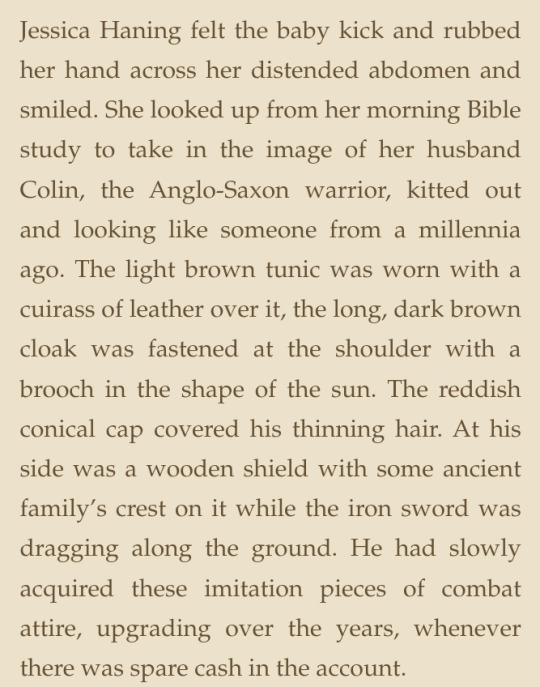
Oh i hope these two get iced. Pregnant or not.
4 notes
·
View notes
Photo

This is a warrior representing a grouping of Germanic peoples known as the Anglo-Saxons, who invaded Great Britain from the area of northern Germany and Denmark beginning in the 400s AD, after the Western Roman Empire had pulled out of the province. Together, the disparate kingdoms they formed in the area would become the country known as England today, with their language evolving into modern English. Originally, the Anglo-Saxons would have practiced a religion related to that of the Norse and other Germanic cultures, but they would convert to Christianity beginning in the late sixth century.
#Anglo-Saxon#English#British#European#medieval#germanic#warrior#swordsman#history#historical#digital art#art
8 notes
·
View notes
Text
"Christ, The Great Warrior Jarl, and His 3 Loyal Viking Thanes"
- inspiration taken from the old anglo-saxon poem

2 notes
·
View notes
Text
So here's one of the coolest things that has happened to me as a Tolkien nut and an amateur medievalist. It's also impacted my view of the way Tolkien writes women.
Here's Carl Stephenson in MEDIEVAL FEUDALISM, explaining the roots of the ceremony of knighthood:
"In the second century after Christ the Roman historian Tacitus wrote an essay which he called Germania, and which has remained justly famous. He declares that the Germans, though divided into numerous tribes, constitute a single people characterised by common traits and a common mode of life. The typical German is a warrior. [...] Except when armed, they perform no business, either private or public. But it is not their custom that any one should assume arms without the formal approval of the tribe. Before the assembly the youth receives a shield and spear from his father, some other relative, or one of the chief men, and this gift corresponds to the toga virilis among the Romans--making him a citizen rather than a member of a household" (pp 2-3).
Got it?
Remember how Tolkien was a medievalist who based his Rohirrim on Anglo-Saxon England, which came from those Germanic tribes Tacitus was talking about?
Stephenson argues that the customs described by Tacitus continued into the early middle ages eventually giving rise to the medieval feudal system. One of these customs was the gift of arms, which transformed into the ceremony of knighthood:
"Tacitus, it will be remembered, describes the ancient German custom by which a youth was presented with a shield and a spear to mark his attainment of man's estate. What seems to the be same ceremony reappears under the Carolingians. In 791, we are told, Charlemagne caused Prince Louis to be girded with a sword in celebration of his adolescence; and forty-seven years later Louis in turn decorated his fifteen-year-old son Charles "with the arms of manhood, i.e., a sword." Here, obviously, we may see the origin of the later adoubement, which long remained a formal investiture with arms, or with some one of them as a symbol. Thus the Bayeux Tapestry represents the knighting of Earl Harold by William of Normandy under the legend: Hic Willelmus dedit Haroldo arma (Here William gave arms to Harold). [...] Scores of other examples are to be found in the French chronicles and chansons de geste, which, despite much variation of detail, agree on the essentials. And whatever the derivation of the words, the English expression "dubbing to knighthood" must have been closely related to the French adoubement" (pp 47-48.)
In its simplest form, according to Stephenson, the ceremony of knighthood included "at most the presentation of a sword, a few words of admonition, and the accolade."
OK. So what does this have to do with Tolkien and his women? AHAHAHAHA I AM SO GLAD YOU ASKED. First of all, let's agree that Tolkien, a medievalist, undoubtedly was aware of all the above. Second, turn with me in your copy of The Lord of the Rings to chapter 6 of The Two Towers, "The King of the Golden Hall", when Theoden and his councillors agree that Eowyn should lead the people while the men are away at war. (This, of course, was something that medieval noblewomen regularly did: one small example is an 1178 letter from a Hospitaller knight serving in the Latin kingdom of Jerusalem which records that before marching out to the battle of Montgisard, "We put the defence of the Tower of David and the whole city in the hands of our women".) But in The Lord of the Rings, there's a little ceremony.
"'Let her be as lord to the Eorlingas, while we are gone.'
'It shall be so,' said Theoden. 'Let the heralds announce to the folk that the Lady Eowyn will lead them!'
Then the king sat upon a seat before his doors and Eowyn knelt before him and received from him a sword and a fair corselet."
I YELLED when I realised what I was reading right there. You see, the king doesn't just have the heralds announce that Eowyn is in charge. He gives her weapons.
Theoden makes Eowyn a knight of the Riddermark.
Not only that, but I think this is a huge deal for several reasons. That is, Tolkien knew what he was doing here.
From my reading in medieval history, I'm aware of women choosing to fight and bear arms, as well as becoming military leaders while the men are away at some war or as prisoners. What I haven't seen is women actually receiving knighthood. Anyone could fight as a knight if they could afford the (very pricy) horse and armour, and anyone could lead a nation as long as they were accepted by the leaders. But you just don't see women getting knighted like this.
Tolkien therefore chose to write a medieval-coded society, Rohan, where women arguably had greater equality with men than they did in actual medieval societies.
I think that should tell us something about who Tolkien was as a person and how he viewed women - perhaps he didn't write them with equal parity to men (there are undeniably more prominent male characters in The Lord of the Rings and The Hobbit, at least, than female) but compared to the medieval societies that were his life's work, and arguably even compared to the society he lived in, he was remarkably egalitarian.
I think it should also tell us something about the craft of writing fantasy.
No, you don't have to include gut wrenching misogyny and violence against women in order to write "realistic" medieval-inspired fantasy.
Tolkien's fantasy worlds are DEEPLY informed by medieval history to an extent most laypeople will never fully appreciate. The attitudes, the language, the ABSOLUTELY FLAWLESS use of medieval military tactics...heck, even just the way that people travel long distances on foot...all of it is brilliantly medieval.
The fact that Theoden bestows arms on Eowyn is just one tiny detail that is deeply rooted in medieval history. Even though he's giving those arms to a woman in a fantasy land full of elves and hobbits and wizards, it's still a wonderfully historically accurate detail.
Of course, I've ranted before about how misogyny and sexism wasn't actually as bad in medieval times as a lot of people today think. But from the way SOME fantasy authors talk, you'd think that historical accuracy will disappear in a puff of smoke if every woman in the dragon-infested fantasy land isn't being traumatised on the regular.
Tolkien did better. Be like Tolkien.
#tolkien#middle earth#jrr tolkien#lord of the rings#lotr#the lord of the rings#eowyn#writing fantasy#fantasy#female characters#writing#historical fiction#medieval women#medieval history#medieval#history#womens history
8K notes
·
View notes
Text
The burials that could challenge historians' ideas about Anglo-Saxon gender
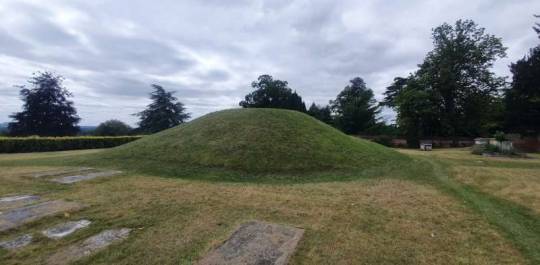
There are a significant number of Anglo-Saxon burials where the estimated anatomical sex of the skeleton does not align with the gender implied by the items they were buried with. Some bodies identified as male have been buried with feminine clothing, and some bodies identified as female have been found in the sorts of "warrior graves" typically associated with men.
In the archaeology of early Anglo-Saxon England, weaponry, horse-riding equipment and tools are thought to signal masculinity, while jewelry, sewing equipment and beads signal femininity. And, for the most part, this pattern fits.
So far though, no convincing explanation has been put forward for the burials which appear to invert the pattern. My Ph.D. research asks whether looking at these atypically gendered burials through the lens of trans theory and the 21st-century language of "transness" has the potential to improve historians' understanding of early Anglo-Saxon gender. Read more.
1K notes
·
View notes
Text
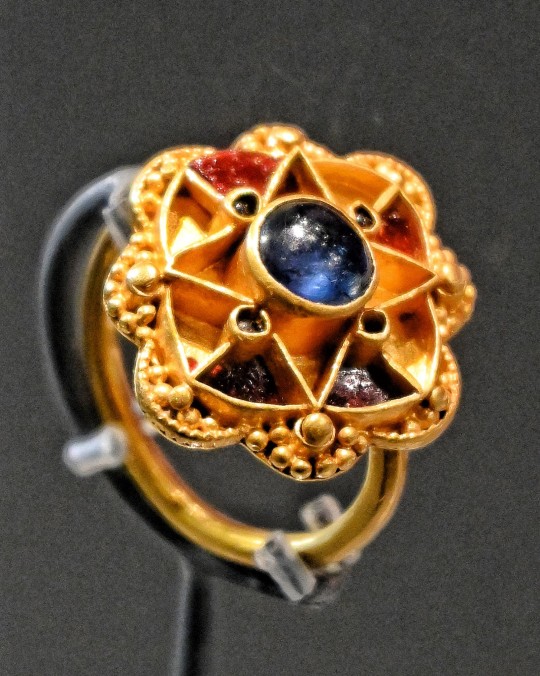
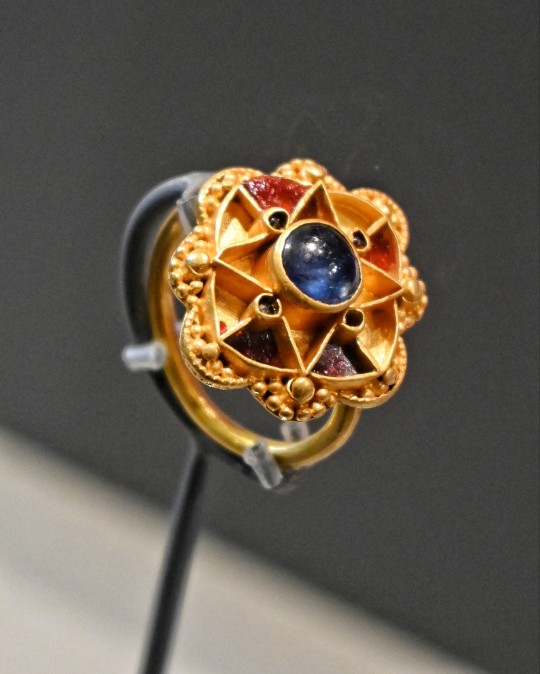
The Escrick Ring, 400 to 600CE, The Yorkshire Museum, York.
Northumbría's Anglican Kings were wealthy, powerful and well-connected. This unique ring. with its large central sapphire, was probably made in france, within territory controlled by Merovingian royalty. It was possibly given to a local ruler as a diplomatic gift.
#escrickring#anglo saxon warrior#anglosaxonart#anglo saxon#metalwork#jewellery#gold jewellery#relic#artefact#archaeology#jewel#ancient culture#ancient craft#ancient art
590 notes
·
View notes
Text

Ancient Saxon Warrior Chief, British Isles.
The costume of the original inhabitants of the British islands, : from the earliest periods to the sixth century; to which is added, that of the Gothic nations on the western coasts of the Baltic, the ancestors of the Anglo-Saxons and Anglo-Danes. By Samuel Rush Meyrick and Charles Hamilton Smith, Esq.
#saxon#warrior#chief#art#engraving#history#anglo saxons#anglo saxon#british isles#britain#costumes#costume#saxons#british islands#england#english
10 notes
·
View notes
Text

Painting of an Anglo Saxon warrior (female) that I made for myself a few years back! Got inspired by Germanic and Celtic regalia, an almost endless source of inspiration for these type of characters..
#dungeons and dragons#board games#concept art#fantasy art#tabletop games#digital painting#magic the gathering#ancient history#character design#armor#anglo saxon#vikings#celtic#germanic
636 notes
·
View notes
Text


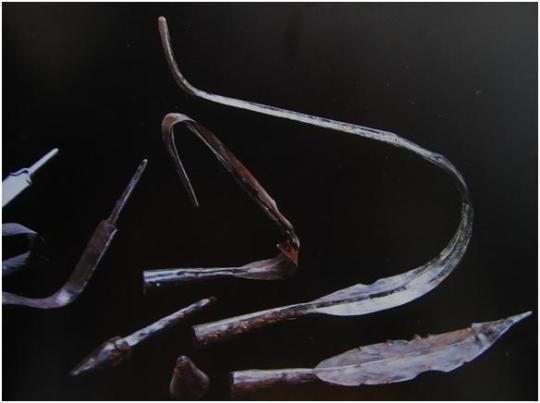
The Ancient Celtic Ritual of Killing a Sword,
During the early iron age up to the rise of the Roman Empire the ancient Celts dominated most of Europe, their tribal societies stretching from Spain in the west to Turkey in the east. One ancient Cetlic tradition was the ritual of “killing” the sword of a deceased chieftain or warrior for burial. Often the sword would be heated, then bent into either a circle or “S” shape thus making it irreparable and useless. In hundreds of Celtic graves throughout Europe such ritually killed swords have been uncovered, one of the most well preserved being a iron sword uncovered near Oss in the Netherlands dating to 700 BC.

There are many possible reasons such a ritual was done by the ancient Celts. The sword could have been killed as a ritual sacrifice to speed the soul of the deceased into the afterlife. Indeed a sword would have made an excellent sacrifice considering the expense and labor needed to craft a quality iron sword in that age. In addition, it may have been a special honor for a particularly brave warrior, and while the warrior rests peacefully in death, likewise his sword should be permanently retired. Kind of like how today we retire the jersey of a famous athlete who passes away. Finally, killing the sword may have a more practical and down to earth purpose, to make it useless if uncovered by thieves and grave robbers.
By around the 1st century AD most Celtic tribes had been overrun by Germanic peoples or conquered and assimilated by the Roman Empire. However the tradition of sword killing continued with many German tribes, and during the early Middle Ages was commonly practiced by the Anglo-Saxons and the Vikings.
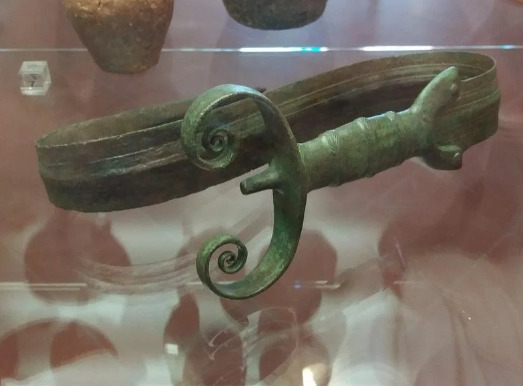
692 notes
·
View notes
Text
These are all true.
#tolkien#silmarillion#lord of the rings#lotr rop#lotr#lotr trop#fantasy#jrr tolkien#the hobbit#weird Tolkien facts#weird facts
351 notes
·
View notes
Note
I'm back with more viking au questions, because I'm a bit excited. Is it a one shot? Planning on both being Scandinavian? Where is it set?
It's likely a multichapter, and Kara is Scandanavian but Lena is Anglo-Saxon. And I'm probably going to set it in Wessex or Mercia!
Here's a lil sneak peek
-
Two of the male warriors are engaged in some kind of game of strength, wrestling each other drunkenly to the ground while the rest of the clan cheers them on, and while Lex is watching the ruckus with a neutral expression Lena has become accustomed to reading his moods from the smallest of cues. His contempt for the Norse is evident from his place at the centre of the high table.
In Lena's distraction the chair beside her, which had been blissfully empty, is filled in a blur of furs and blonde hair.
It's the woman who had been at Clark Jorelsson's side this morning. The one whose intense gaze had lit Lena aflame.
"Gods, I'm thirsty," the woman says, grabbing the nearest mug of ale and downing half its contents in a few moments. She's panting for breath when she finishes, a thin line of foam gracing her upper lip as she grins. "What I wouldn't give for some good honey-mead!"
"Is our ale not sufficient?" Lena says delicately. She folds one leg over the other, and the flaxen-haired woman's eyes dart down to track the movement. They stay there perhaps a shade longer than is proper.
"Simply an unfamiliar brew. But I am a far-traveller. I search out new experiences," the woman says, setting the mug down with more restraint than her brethren – these Norse are all so loud, so exuberant in their feasting. Singing and shouting and fighting with each other for sport. This woman is quieter than the rest, despite her warrior's stature. Her presence is a balm.
Lena hums. "And here I thought all Norse warriors were simply machines of war."
The woman snorts. "Only when we have to be."
"Tell that to the monks at Lindisfarne."
The woman's grin widens. She stares at Lena for a moment, seeming delighted despite Lena's borderline antagonism, and finally she holds out an arm to clasp.
"I am Kara Zorelsdottir. Clark is my kin."
"Ah. So you are to be my kin too, then?" Lena says, her own words tasting bitter in her mouth. The reminder of a marriage she didn't agree to. She glances across the room, where Clark is sitting slumped in his seat with a mug of ale in each hand. He looks about as thrilled with the situation as Lena feels.
She takes Kara's arm. The blonde's grip is firm and strong; the defined muscles of her forearm shift under Lena's hand, hidden by her furs. Kara's smile dims a little at Lena's words.
"That seems to be the way of it."
Kara's grip loosens. Lena finds she's loath to let it go, but she releases Kara's arm and settles back in her seat.
"My clan tries to make violence a last resort," Kara explains. When a passing servant moves to refill her mug as he passes, Kara holds a hand over it with a shake of the head. "Which is why we left home. Got tired of all the raiding. We just want to live in peace."
"And my marriage to your cousin is what will seal it for you," Lena says. Kara's mouth forms a tight line. The sputtering torches and roaring hearth fire in the centre of the hall flicker across her face, throwing her handsome features into stark detail.
"That’s Jonn’s hope."
"Clark himself doesn’t seem to hold the same hope," Lena notes with a nod in his direction. Kara chuckles humorlessly.
"He has a beloved back in Norway. Her father disapproved of the match, but he still pines for her." Kara takes an idle swig of her half-full ale. "I think he’s crazy for not jumping for joy when he saw you."
Lena's heart kicks a fierce drumbeat in her chest.
"Do you?" Lena says, managing to keep her voice even with great effort. Kara shrugs. She pulls a coin from her pocket, flicking it between her fingers in a thoughtless movement that Lena is sure took much practice.
"I told him if he’s to have a chosen match, at least he got the most beautiful one in Christendom."
Lena's whole body flushes with pleasant warmth.
156 notes
·
View notes